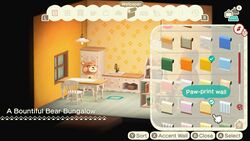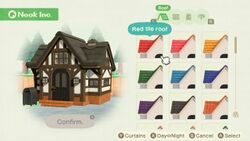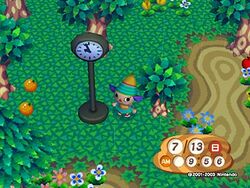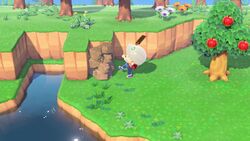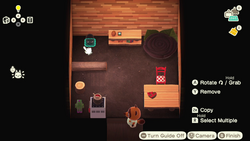Designing
Designing (or decorating) is a gameplay mechanic in the Animal Crossing series that features the player customizing either their own house, their own town/island, or someone else's house, whether that be a villager or a special character. A major aspect in designing is the placement of furniture items and other miscellaneous items such as clothing or gyroids.
Two types of designing, interior and exterior, focuses on different designing mechanics. Interior designing features the decoration of a house's walls, flooring, and ceiling (only in Happy Home Designer and New Horizons as of version 2.0). Exterior designing takes the form of how certain structures are placed, and may also involve the placement of trees and flower items. The player can check on how their designing is graded, with the Happy Home Academy for their own house, and the environment evaluation check for their town or island.
Until New Leaf, interior designing remained a major focus in the Animal Crossing series, with minor exterior designing in regards to how flora is placed and in Doubutsu no Mori e+ special objects ordered by the player. Exterior designing would be expanded in Animal Crossing: New Leaf with the introduction of public works projects, while also introducing wall-mounted items to be placed on the player's wall. The museum's exhibit room can also be designed. In Pocket Camp, much of the player's designing takes place around their campsite, camper and cabin, with the ability to place furniture outside. This would continue into New Horizons, where the player can also relocate buildings such as the Able Sisters or a villager home and be able to construct up to ten bridges and ten inclines for the player's island. The player can also design in the Room Sketch app or at Photopia on Harv's Island.
In Happy Home Designer and the New Horizons DLC Happy Home Paradise, designing is a major focus in which the player designs a custom house for a client, whether that is a villager or a special character. House designs can be shared to other players via the Happy Home Network.
Aspects of designing[edit]
Furniture[edit]
Furniture are items that can be used in designing. Before Happy Home Designer, furniture items were mainly available only for the inside of the player's house (and in New Leaf, one of the museum's exhibits). In Happy Home Designer, Pocket Camp, and New Horizons, furniture items can now be placed outdoor. Furniture items primarily come from Tom Nook's store or Timmy and Tommy's store depending on the game.
Furniture items can either be placed on the floor, on other furniture items, on the wall, or on the ceiling. Some items can perform different functions, such as a seat or a bed that the player can sleep on (and enter a dream island in New Horizons since version 1.4.0).
Furniture items can come in certain furniture series or furniture set that can improve Happy Home Academy evaluation for the player's house. Each can also be assigned a specific theme that when paired together can also improve the player's house evaluation. In New Horizons, furniture items are essential for the player's island evaluation rating.
Wallpaper/Flooring[edit]
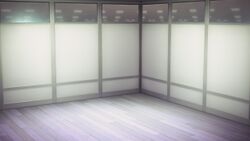
Wallpaper and flooring (carpets prior to Happy Home Designer) are items that are used primarily in interior designing. When obtaining a house, a default wallpaper and flooring is applied that the player can then change later. In New Horizons, the player can also set an accent wallpaper, where another wallpaper is applied to one side of a room. Accent wallpapers are unlocked with the Pro Decorating License or playing the Happy Home Paradise DLC for the first time (if the Pro Decorating License was purchased prior to playing Happy Home Paradise, it is refunded). Wallpaper and flooring items can be purchased from Tom Nook's store or Timmy and Tommy's store depending on the game.
Special wallpapers and flooring tend to feature a unique image, and can sometimes be animated. For instance, the underwater wall features moving fishes and waves. These special interior items can primarily be obtained from Saharah.
House customization[edit]
House customization is a major mechanic in the aspect of exterior designing. In Animal Crossing, the only customization available was the repainting of the roof on the player's house, which can be changed by any villager. In City Folk, a small flag is placed on the player's house after completely paying off the mortgage and can be customized.
In New Leaf, house customization was expanded, now allowing the player to change the roof, door, exterior, fence, framework, mailbox, and pavement for ![]() Bells. In New Horizons, customization was limited to only changing the roof, door, siding, and mailbox. Additional customization options for a house were added in version 2.0, including the inclusion of house shape, where the player can now choose between four different shapes.
Bells. In New Horizons, customization was limited to only changing the roof, door, siding, and mailbox. Additional customization options for a house were added in version 2.0, including the inclusion of house shape, where the player can now choose between four different shapes.
In Happy Home Paradise, when designing a villager's vacation home or when redesigning an existing villager's home after completing the DLC, it is possible to also change the villager's exterior.
Bridges[edit]
Bridges are an exterior designing mechanic. In Animal Crossing, Doubutsu no Mori e+, and City Folk, the player is only able to decide the location of a new bridge to be built, and cannot change what type of bridge to build. In New Leaf and New Horizons, new bridge types were added and can be built. Only three bridges are allowed for a town in New Leaf, while ten are allowed in New Horizons.
Flora[edit]
Flora is often used in the aspect of exterior designing. Flowers, trees, weed, and bushes are common elements that the player can use to decorate their town or island. In New Horizons, it's possible to move trees or bushes around using a shovel, although the former requires that the player eats a food item to gain energy points.
Other aspects of flora include bamboo and rocks, although the latter can only be moved in New Horizons and requires that the player breaks the rock and allow it to respawn in a new location.
Objects[edit]
Objects are structures in Doubutsu no Mori e+ used in exterior designing. Three random objects are available from Tom Nook and can be constructed after finding a location and paying a fee of ![]() Bells. Other objects are ordered by ways of code generation via the now-defunct Object Delivery Center. Building an object is permanent, and only one can be built at a time.
Bells. Other objects are ordered by ways of code generation via the now-defunct Object Delivery Center. Building an object is permanent, and only one can be built at a time.
Public works projects[edit]
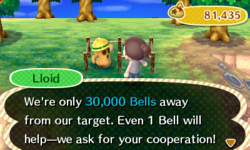
Public works projects are structures in Animal Crossing: New Leaf used in exterior designing. These projects can be chosen by the mayor, with Isabelle providing a list of structures to choose from. Many projects can be unlocked from random villagers, though some are unlocked in unique ways. Only one public works project can be done at a time.
Once a public works project is given a location, Lloid will appear and collect ![]() Bells donations to build the structure. While villagers may donate to a project from time to time, the player is expected to donate and finish the project themselves. Once the public works project donation is successful, it will open up the next day. Isabelle will give the player the option to choose whether or not to celebrate its opening.
Bells donations to build the structure. While villagers may donate to a project from time to time, the player is expected to donate and finish the project themselves. Once the public works project donation is successful, it will open up the next day. Isabelle will give the player the option to choose whether or not to celebrate its opening.
Up to 30 public works project can build for a single town, while only three bridges can be built. Some public work project involve construction around Main Street, where Lloid collect donations at the train station instead.
Soundscapes[edit]

Soundscapes (sound sceneries in Happy Home Designer) are a mechanic primarily used in interior designing. These add ambient sound to the interior of the house. In Happy Home Designer, sound sceneries can be brought for ![]() 2 Play Coins.
2 Play Coins.
In Happy Home Paradise, the player has 23 total soundscapes to choose from. All are obtained by Wardell when he is outside at the northern part of the main archipelago island after completing 17, 25, and 33 vacation homes.
Rugs[edit]
Rugs are items introduced in Happy Home Designer that are primarily used in designing. Rugs would return in Pocket Camp and New Horizons. With the exception of New Horizons, all rug items can be used in the outside. Rugs come in several different sizes, either small, medium, or large. Once placed down, the player can walk over the item itself.
In New Horizons, rugs are generally sold by Saharah.
Amenity[edit]
Amenities are items in Pocket Camp that are primarily used in exterior designing for the campsite. Three tiers of amenities exists for each of the ten themes in Pocket Camp, and are able to boost a villager's friendship level in the process. However, some amenities are only available during events and have no impact on friendship. Only two amenities can be placed at a time.
Terrain[edit]
Terrain are items in Pocket Camp that are primarily used in exterior designing for the campsite. Terrains come in various parts: Sky, Background, Middle Ground, and Foreground. The player can also add a Sign, Fence, and Deck that are fixed to one location and cannot be moved. Each Terrain part correlates to a set, and certain parts can come from seasonal goods or Fortune Cookie.
Once the player is done setting up the Terrain, they can view what the Terrain will look like under different times of day and seasons.
Fences[edit]
Fences are items in New Horizons that are primarily used in exterior designing. Fences can be placed in any direction, though only the same fence can connect to each other. When plotting a fence down, the player will hold a hammer-like tool.
Incline[edit]
Inclines are an exterior designing mechanic. Until New Horizons, incline were only available for certain parts of a town and were not customizable. In New Horizons, the player can purchase up to 10 inclines to place around their island between two different cliff levels.
Island Designer[edit]
The Island Designer Construction Permit app in New Horizons allows the player to construct cliffs, waterways, and paths. It is an exterior designing mechanic. After obtaining a 3-star rating and having K.K. Slider perform for the first time on the player's island, the player receives the Island Designer app and can create paths around the island. The player will need to spend ![]() Nook Miles for additional paths and have the ability to make cliffs and waterways.
Nook Miles for additional paths and have the ability to make cliffs and waterways.
Certain limits are imposed when using this app. While the player can make a fourth level cliff, they cannot climb it. They also can't remove a cliff if it's around a tree or if an object like a flower is on top of it. Waterways also can't be created near trees and any waterfalls will need to have a cliff on its side. The area where Resident Services is located also cannot feature cliffs or waterways.
Polishing[edit]
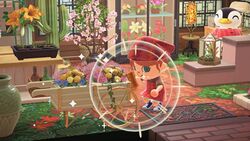
Polishing is a mechanic introduced in the New Horizons DLC Happy Home Paradise primarily used in interior designing. When wanting to polish the interior of their own, a villager's house, or a vacation home, the player has to select the L button, which will switching them to polishing mode and change their headwear and shirt.
The player can then select from one of 14 different polishing effects and then rub on a nearby item. The effect can be intensified if polished long enough. Custom designs can also be applied to the effect which will replace the texture that is shown when polishing is applied.
Polishing is unlocked while completing the fourth house for Paradise Planning.
Lighting[edit]
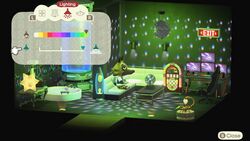
Lighting is an interior designing mechanic introduced in the New Horizons DLC Happy Home Paradise. Lighting is composed of color and brightness. The player can change the color of light to one of 12 options: white, yellow, orange, red, pink, magenta, purple, blue, light blue, aqua, green, and lime green. The player can also adjustment the brightness, either dimming or brightening the room.
Lighting is unlocked while designing either the café or restaurant.
Entryway[edit]
Entryways is a interior designing mechanic introduced in the New Horizons DLC Happy Home Paradise. It is unlocked once starting the DLC. There are eight Entryways that the player can choose from.
| Image | Description |
|---|---|
| A wooden entryway. Default for player's houses. | |
| A dark-wooden entryway. Default for any villager's houses. | |
| A white tile entryway. Default for the room inside the Room Sketch app. | |
| A brick entryway. | |
| A stone entryway featuring a red rug. | |
| An stone entryway. | |
| An dark-stone entryway, featuring pebble-like patterns. |
Other designing aspects[edit]
Other designing aspects include the placement of clothing, gyroids, art, bugs, fish, sea creatures, tools, and other items. Custom designs can also be used in designing, whether placed on the ground or with its pro design placed down.
Relocation of a villager's house or a building is also a designing mechanic in New Horizons, although the relocation of Resident Services requires the rebuilding of the player's island.
Designing UI[edit]
Starting in Happy Home Designer, a new UI was made for the designing process. In Happy Home Designer, the player can choose from different categories to place down a furniture item. Once plotted, the player can move the item around on the touchscreen. The player can also move characters for the purposes of taking a photo. Furniture items that don't have a surface for the placement of other items have dots in the UI, while furniture items that do have surfaces for other items have pluses. Furniture item that can be placed on other items or on the floor are round and have pluses, while other furniture items are square-like in comparison.
In New Leaf's Welcome amiibo update, after building the Secret Storage, the player is shown over to Lottie, who grants the player the ability to use a similar designing UI of that used in Happy Home Designer. This allows the player to move furniture around with a similar mechanic used in regards to surface furniture, but it does not grant the player the ability to access their storage to place down new furniture items.
In New Horizons, the player can go into a designer UI by pressing anytime while designing their own house, a villager's house, at Photopia, or when designing a vacation home in the Happy Home Paradise DLC. Going into the Room Sketch app automatically places the player into the designer UI.
Using , the player is able to move the cursor around and move a furniture item by holding
. To remove a furniture, the player can press
. The player can rotate a furniture item by pressing
, while they can select multiple furniture items by pressing
. Pressing the plus button switches between three modes: standard furniture, wall-mounted furniture, and ceiling decor furniture. To access storage, the player can press
, while to access their pockets for items, the player can press
. Pressing
on a furniture item that can be customized will load up the standard customization UI. Pressing
toggles the lighting of a room. If the player has gotten the Happy Home Paradise and has made progress, the player can press
for resizing, lighting adjustments, entryway changes, windows adjustments, and soundscapes. Pressing
hides the UI guides. Once the player is done, the player can press
to quit the UI.
In Happy Home Paradise only, the player can also design outside. In the UI, pressing the plus button switches the player between multiple modes of exterior designing: standard furniture, fences, and paths. Pressing allows the player to set the default time. Pressing
brings up the catalog, while pressing
shows a selection of seasons that the player can set the property in.
| Gameplay elements | ||||||||||||||||||||||||||
|---|---|---|---|---|---|---|---|---|---|---|---|---|---|---|---|---|---|---|---|---|---|---|---|---|---|---|
| ||||||||||||||||||||||||||
